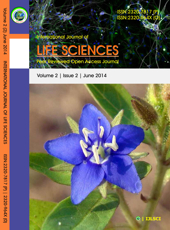DNA based Survey of Protozoan Parasites in some common herpatofauna of Amravati-Maharashtra (India)
Keywords:
Apicomplexan, Hepatozoon, herpatofauna, 18S rRNAAbstract
The study of parasite diversity not only helps to estimate the diversity of organisms but also help to address question related to host specificity and coevolution. Hepatozoonosis, is an enzootic disease caused by several species of Hepatozoon, a genus in the phylum Apicomplexa. Hepatozoon infect wide variety of domestic and wild animals. The present pilot study was aimed to screen the common herpatofauna namely garden and wall lizard for the presence of Hepatozoon species using DNA based markers specific for 18S rRNA region. The findings of this study confirms the occurrence of Hepatozoon in garden and wall lizard using HepF300 and HepR900 primers targeted for ~800 bp of 18S rRNA gene. The study also highlights the need to screen more taxa for the occurrence of this parasite in both domestic and wild species to understand parasetemia caused by Apicomplexan species.
Downloads
References
1. Baneth Gad, Mathew John S, Shkap Varda, Macintire Douglass K, Barta John R and Ewing Sidney A (2003) Canine hepatozoonosis: two disease syndromes caused by separate Hepatozoon spp. TRENDS in Parasitology, 19(1): 27–31.
2. Baticados Abigail M, Baticados Waren N, Carlos Enrique T, Carlos Sixto MEAS, Villarba Lorelie A, Subiaga Sherlyn G, Magcalas Jomarte M (2010) Parasitological detection and molecular evidence of Hepatozoon canis from canines in Manila, Philippines. Veterinary Medicine: Research and Reports, 7–10.
3. Brooks Daniel R and Hoberg Eric P (2007) How will global climate change affect parasite–host assemblages? TRENDS in Parasitology, 23(12): 571-574
4. Boulianne B, Evans RC, and Smith TG, (2007): Phylogenetic analysis of hepatozoon species (apicomplexa: adeleorina) infecting frogs of nova scotia, canada, determined by its-1 sequences. J. Parasitol., 93(6): 1435–1441.
5. Criado-Fornelio A, Martinez-Marcos A, Buling-Saraña A b, Barba-Carretero JC (2003) Molecular studies on Babesia, Theileria and Hepatozoon in southern Europe Part I. Epizootiological aspects. Veterinary Parasitology, 113: 189–201.
6. Forlano M, Scofield A, Elisei C, Fernandes KR, Ewing SA, Massard CL (2005) Diagnosis of Hepatozoon spp. in Amblyomma ovale and its experimental transmission in domestic dogs in Brazil. Vet Parasitol, 134: 1–7.
7. Forlano MD, Teixeira KRS, Scofield A, Elisei C, Yotoko KSC, Fernandes KR, Linhares GFC, EwingH SA, Massard CL (2007) Molecular characterization of Hepatozoon sp. from Brazilian dogs and its phylogenetic relationship with other Hepatozoon spp. Veterinary Parasitology, 145: 21–30.
8. Gardner SL and Campbell ML (1992) Parasites as a probe of Biodiversity. Journal of Parasitology, 78: 596-600.
9. Gonen L, Strauss-Ayali D, Shkap V, Vincent-Johnson N, Macintire DK, Baneth G (2004) An enzyme-linked immunosorbent assay for antibodies to Hepatozoon canis. Vet Parasitol, 122 (2): 131-9.
10. James SP (1905) On a parasite found in the white corpuscles of the blood of dogs. Scientific Memoirs by officers of the Medical and Sanitary Departments of the Government of India, 14: 1-13.
11. James Harris D, Joa˜o PMC Maia, and Ana Perera (2012) Molecular survey of Apicomplexa in Podarcis wall lizards detects Hepatozoon, Sarcocystis, and Eimeria species. J. Parasitol., 98(3): 592-597.
12. Paterson Steve and Piertney Stuart B. (2011): Frontiers in host–parasite ecology and evolution. Molecular Ecology, 20: 869–871.
13. Poulin R. and Mouillot D. (2005): Combining phylogenetic and ecological information into a new index of host specificity. Journal of Parasitology, 91: 511-514.
14. Renaud F, Clayton D, De Meeus T (1996) Biodiversity and evolution in host-parasite associations. Biodiversity and Conservation, 5: 963 – 974.
15. Smith TG (1996): The genus Hepatozoon (Apicomplexa: Adeleina). Journal of Parasitology, 82: 565–585.
16. Smith T and Desser S (1997) Phylogenetic analysis of Hepatozoon Miller, (1908) Apicomplexa –Adeleorin. Syst. Parisitol, 36: 213-221.
17. Telford SR (1984) (2009) Haemoparasites of reptiles. In Diseases of amphibians and reptiles, G. L. Hoff F. L. Frye, and E. R. Jacobson (eds.). Plenum Publishing Corporation, New York, 385–517.
Downloads
Published
How to Cite
Issue
Section
License
Copyright (c) 2014 Author

This work is licensed under a Creative Commons Attribution-NonCommercial-NoDerivatives 4.0 International License.
Open Access This article is licensed under a Creative Commons Attribution 4.0 International License, which permits use, sharing, adaptation, distribution and reproduction in any medium or format, as long as you give appropriate credit to the original author(s) and the source, provide a link to the Creative Commons license, and indicate if changes were made. The images or other third party material in this article are included in the article’s Creative Commons license unless indicated otherwise in a credit line to the material. If the material is not included in the article’s Creative Commons license and your intended use is not permitted by statutory regulation or exceeds the permitted use, you will need to obtain permission directly from the copyright holder. To view a copy of this license, visit http://creativecommons.org/ licenses/by/4.0/











